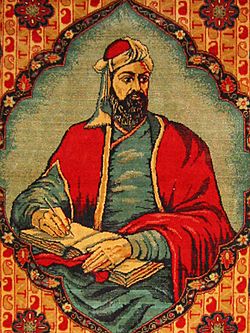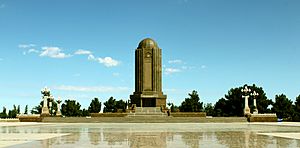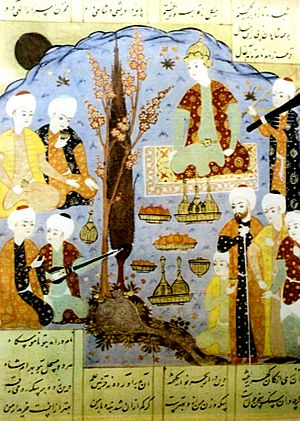Nizami Ganjavi facts for kids
Quick facts for kids
Nizami (Ganjavi)
|
|
|---|---|

Rug depiction of Nizami Ganjavi (1939). Ganja Museum, Azerbaijan.
|
|
| Born | 1141 (approximate) (Earlier date around c. 1130 has also been suggested) Ganja (Seljuk Persia, modern-day Azerbaijan) |
| Died | 1209 Ganja (Shirvanshah dynasty, modern-day Azerbaijan) |
| Period | 12th century |
| Genre | Romantic Persian epic poetry, Persian lyrical poetry, wisdom literature |
| Notable works | The Five Jewels (Panj Ganj) |
Nizami Ganjavi (Persian: نظامی گنجوی, romanized: Niẓāmī Ganjavī, lit. 'Niẓāmī of Ganja') (1141–1209), Nizami Ganje'i, Nizami, or Nezāmi, whose formal name was Jamal ad-Dīn Abū Muḥammad Ilyās ibn-Yūsuf ibn-Zakkī, was a 12th-century Persian Sunni Muslim poet. Nezāmi is considered the greatest romantic epic poet in Persian literature, who brought a colloquial and realistic style to the Persian epic. His heritage is widely appreciated and shared by Afghanistan, Azerbaijan, Iran, the Kurdistan region and Tajikistan.
Life
Born of a Persian family, his personal name was Ilyas and his chosen pen-name was Nezami (also spelled as Nizami and Neẓāmi). He was born of an urban background in Ganja (Seljuq empire, now Republic of Azerbaijan) and is believed to have spent his whole life in South Caucasus. Nizami was orphaned early and was raised by his maternal uncle Khwaja Umar who took responsibility for him and afforded him an excellent education.
Because Nezami was not a court poet, he does not appear in the annals of the dynasties. Tazkerehs, which are the compilations of literary memoirs that include maxims of the great poets along with biographical information and commentary of styles refer to him briefly. Much of this material in these Tazkerehs are based on legends, anecdotes, and hearsays. Consequently, few facts are known about Nezami's life, the only source being his own work, which does not provide much information on his personal life.
Education
Nezami's poems show that not only he was fully acquainted with Arabic and Persian literatures and with oral and written popular and local traditions, but was also familiar with such diverse fields as mathematics, astronomy, astrology, alchemy, medicine, botany, Koranic exegesis, Islamic theory and law, Iranian myths and legends, history, ethics, philosophy and esoteric thought, music, and the visual arts.
Family
Nizami was married three times. His first wife was an enslaved Kipchak who was sent to him by Fakhr al-Din Bahramshah, the ruler of Darband, as part of a larger gift. According to Iraj Bashiri she became Nezami's "most beloved" wife. His only son Mohammad was from this wife. She died after "Khosrow and Shirin" was completed. Mohammad was seven at the time.
Works
Nezami lived in an age of both political instability and intense intellectual activity, which his poems reflect. He dedicated his poems to various rulers of the region as was custom of that time for great poets, but avoided court life. Nezami was a master of the Masnavi style (double-rhymed verses).
Legacy

Nizami, whose works are all written in Persian, has a very high reputation in Iran, Afghanistan and Tajikistan, where Persian is the official language. His poetry is especially well known in Iran, and is also very popular in Azerbaijan, where his birthplace and mausoleum are located. He is known in other countries, especially in India and Pakistan .
The Soviet ballet produced a film, Leili and Medjnun, named after a poem by Nizami Gandjevi. The ballet "Seven Beauties" by Azerbaijani composer Gara Garayev, based on Nezami's famous poem, won an international acclaim.
A minor planet 3770 Nizami, discovered by Soviet astronomer Lyudmila Chernykh in 1974 is named after him. The Museum of Azerbaijan literature in Baku is named after Nezami.

Nezami was depicted on the obverse of the Azerbaijani 500 manat banknote of 1993–2006. In 2008, coinciding with the 800th anniversary of his death, the National Bank of Azerbaijan minted a 100 manat gold commemorative coin dedicated to his memory.
The Nizami Museum of Literature is located in Baku, Azerbaijan. One of the Baku Metro stations is also named after Nizami Ganjavi. There is Institute of Literature named after Nizami and Cinema named after Nizami in Baku. One of the districts of Baku is called Nizami raion. The life of Nizami Ganjavi is shown in the Azerbaijani movie "Nizami" (1982), in which the leading role, role of Nizami Ganjavi, was played by Muslim Magomayev. The Nizami Mausoleum, built in honor of Nizami, stands just outside the city of Ganja in Azerbaijan. It is a tall cylindrical building, surrounded by gardens. To one side, there is a metal statue commemorating Nizami's epic poems. The mausoleum was originally built in 1947 in place of an old collapsed mausoleum, and rebuilt in its present form after Azerbaijan Republic regained its independence after the fall of the Soviet Union in 1991.
Monuments to Nezami are found in many cities of Azerbaijan and Iran, as well as in Moscow, St. Petersburg and Udmurtiya (Russia), Kiev (Ukraine), Beijing (China), Tashkent (Uzbekistan), Marneuli (Georgia), Chişinău (Moldova), Rome (Italy).
Images for kids
-
Alexander sharing his throne with Queen Nushabah, taken from the Sharaf-Nama owned by the Sultan of Bengal Nasiruddin Nasrat Shah. (British Library)
-
Practice Makes Perfect from a Haft Peykar of Nizami. Brooklyn Museum.
-
Nizami Museum of Azerbaijani Literature in Baku, Republic of Azerbaijan.
-
Page from an Illustrated Manuscript of the "Khamsa" by Nizami. Brooklyn Museum.
-
1543 illustration of the Mi'raj from the Khamsa, probably created by the court painter Sultan Muhammad. This version was created for the Persian Shah Tahmasp I.
See also
 In Spanish: Nezamí Ganyaví para niños
In Spanish: Nezamí Ganyaví para niños















